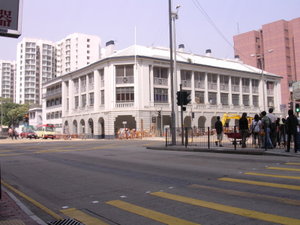
Sham Shui Po Police Station
Encyclopedia

Chinese language
The Chinese language is a language or language family consisting of varieties which are mutually intelligible to varying degrees. Originally the indigenous languages spoken by the Han Chinese in China, it forms one of the branches of Sino-Tibetan family of languages...
深水埗警署) situates at the junction of Lai Chi Kok Road
Lai Chi Kok Road
Lai Chi Kok Road is a road in the western part of New Kowloon, Hong Kong. It links Lai Chi Kok to Mong Kok, via Tai Kok Tsui, Sham Shui Po and Cheung Sha Wan. It starts from the junction with Nathan Road near Pioneer Centre in the south and ends near Mei Foo Sun Chuen...
and Yen Chow Street
Yen Chow Street
Yen Chow Street is a main street in Sham Shui Po of New Kowloon in Hong Kong. The street runs from hill side towards the shore. It spans from Castle Peak Road to Sham Mong Road. Its extension Yen Chow Street West spans further to the reclamation shore.-Name:The street was named after Yen Chow,...
, Sham Shui Po
Sham Shui Po
Sham Shui Po, or Shamshuipo, is an area of Sham Shui Po District, Hong Kong, situated in the northwestern part of the Kowloon Peninsula, north of Tai Kok Tsui, east of Cheung Sha Wan and south of Shek Kip Mei. Sham Shui Po is known for its street market for electronic devices.-History:Sham Shui Po...
. It was built in 1924 with three storeys.
It is graded as Grade III historic building.
The police station is adjacent to former Sham Shui Po Camp and later Dragon Centre
Dragon Centre
Dragon Centre is a nine-storey shopping centre in the Sham Shui Po district of Kowloon, Hong Kong; it was the largest in West Kowloon until the Elements opened its doors in above the Kowloon MTR Station.- History :...
.
Shortly after the British executed the 99-year lease of the New Territory, a police station, also served as the Harbour Master’s Station, was built at Sham Shui Po. British established a base at Sham Shui Po with military camps and police stations as it overlooked the western side of the Victoria Harbour. The current Sham Shui Po Police Station building was completed in 1924 to replace the older station at the area.
The building was built before World War II
World War II
World War II, or the Second World War , was a global conflict lasting from 1939 to 1945, involving most of the world's nations—including all of the great powers—eventually forming two opposing military alliances: the Allies and the Axis...
for a small population, before the rapid industrial and residential development of the area after the war. In addition, a large influx of immigrants from mainland China, settling in the area after the war, caused the district to become one of the worst squatter areas in Hong Kong. Therefore, the station underwent a series of additions and alterations to cater for its growing need for personnel and facilities.
Sham Shui Po Station is still serving its community today even though its role changed from the station for the whole district to a sub-station in 1967.

